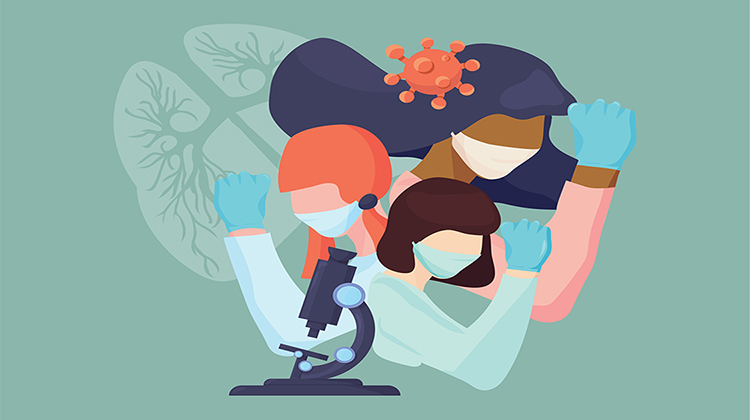Women in Stem with Stefanie Flückiger-Mangual
Posted: 6 May 2024 | Stefanie Flückiger-Mangual (TOLREMO Therapeutics) | No comments yet
Stefanie Flückiger-Mangual, Chief Executive Officer, is one of TOLREMO’s scientific founders and an expert in drug resistance in cancer therapy. She is a biomedical scientist and biochemist by training (University of Fribourg and ETH Zurich, Switzerland) and holds a PhD in Molecular and Translational Biomedicine from ETH Zurich. She led the team of scientists who discovered novel molecular mechanisms that can be exploited to prevent the development of non-genetic resistance to cancer therapies.


Can you tell us about your journey in the field of STEM and the challenges you encountered along the way?
My journey in STEM has been both challenging and immensely fulfilling. Early in my career, I had a bad experience in one of my first jobs, helping in the lab as a young student. My professor’s seeming support of my work quickly shifted into a more personal interest in me. It was, quite frankly, devastating and demoralising. I started questioning myself and my abilities as an aspiring scientist. Later, as a graduate student, I was fortunate to work in a lab where we were given total scientific freedom as long as we asked bold questions and worked hard to find answers. Gender was never an issue; we were all just scientists. It was one of the most inspiring and liberating experiences I ever had as a scientist.
What inspired you to pursue a career in STEM, and how did you overcome any obstacles or biases you may have faced?
Paradoxically, this first lab experience that unfortunately took an inappropriate turn sparked my interest in potentially pursuing a career in STEM. I have always had a deep-rooted curiosity about the natural world and a desire to observe natural phenomena around me. Even as a child, I kept a notebook to track the growth of a tiny plant I got as a gift from my father. But I didn’t have any role models around me. My parents didn’t attend college, and I didn’t know any scientists. That first lab experience gave me a glimpse of what life could be when you get paid to observe things and try to make sense of the world around you. What a job! When the issues with my professor arose, I actually finished my work with him – it was my final project as an undergrad – and then I switched universities. Luckily, my love for science remained.
Could you share an example of a specific project or research that you have worked on and the impact it has had in your field?
During my PhD, I worked on resistance development to BRAF inhibitors in BRAFV600E mutated melanoma. The first BRAF inhibitors had been approved based on very promising clinical results. For the first time, it seemed, we had a solution for this cancer that was so notoriously resistant to any therapeutic approach. However, it turned out that the stunning initial clinical results – dramatic tumour shrinkage within just a couple of weeks – were unfortunately short-lived. The clinical efficacy of BRAF inhibitors, like most other targeted cancer therapies, is inevitably limited by resistance development. This caused many scientists to study the mechanisms that drive drug resistance. Melanoma was an ideal disease for studying this phenomenon because cutaneous tumour biopsies are readily available. While most groups focused their work on samples from already resistant tumours, I was encouraged to ask a different question: What if the first signs of resistance are already detectable in the tumour from the first day of therapy? What if this gives us a way to prevent resistance development before it can become clinically meaningful? We found that, indeed, cancer’s earliest defence mechanisms are triggered almost immediately after exposure to a targeted cancer therapy. We discovered that transcriptional reprogramming events are an early survival strategy cancer cells use to buy time until they are fully drug-resistant and drive clinical relapses.
How has your research in STEM contributed to advancements or improvements in your field, and what potential future applications or implications do you foresee based on your work?
We kept asking bold questions until one day, we asked, “What if we can use our discoveries to actually develop novel therapies? What if our science can directly impact patients’ lives?” This led to the spin-out of TOLREMO therapeutics AG, a now clinical-stage biotech aiming to prevent resistance development to targeted cancer therapies. Always following the science, we succeeded in developing a novel chemical scaffold and discovering a novel resistance modulator. Our small molecule TT125-802 inhibits the bromodomain of the transcriptional co-activators CBP/p300 and thereby prevents resistance development to a whole range of cancer drugs. We generated stunning preclinical data and are currently running the first clinical trial in cancer patients. If we can show that with this novel mode of action we can indeed increase clinical benefit for patients, it will have a profound impact on how we approach the way we treat cancer. There might be a way to proactively prevent resistance development before it is too late. It’s a really exhilarating thought.
As a woman in STEM, what unique perspectives or strengths do you believe you bring to your work?
We all – men and women – bring our own unique perspectives and strengths to our work. My experiences have taught me to approach problems from diverse angles and to value collaboration and inclusivity in all endeavours. I strongly believe that diversity in all its facets – gender, age, origin, personality – drives innovation. By embracing our own identities, no matter who you are and where you are from, we can contribute to a more dynamic and creative research community.
What advice would you give to young women who are considering a career in STEM but may be hesitant due to societal stereotypes or perceived challenges?
Believe in yourself, seek out mentors and role models who can support, guide, and challenge you, and don’t be afraid to challenge societal stereotypes and expectations. STEM fields thrive on diversity, and your unique perspective and talents have the potential to make a significant impact on the world. Keep asking those bold questions, and don’t take no for an answer.
How do you see the representation of women in STEM changing over the years, and what further progress do you believe is needed?
The representation of women in STEM has improved in recent years, but there is still much work to be done to achieve true gender equity. We must keep challenging the status quo and include more members of our community – especially men – to strive for a more inclusive environment. People need to understand the true value of diversity and inclusion. It’s not a nice thing to do. It’s essential for the performance and competitiveness of our businesses and the progress of science in general. Different minds provide different solutions to different problems. As leaders, we must ensure our organisations can weather any storm – diversity is an important part of the solution.
In your opinion, what can organisations and institutions do to create a more inclusive and supportive environment for women pursuing STEM careers?
It’s a fine line between specifically encouraging women to step up and throw their hat in the ring and alienating men who rightfully want to pursue their own careers. Some might think, of course women call for more diversity – after all, they are the ones whose careers get advanced. So it’s crucial to include men in the conversation and get men to advocate for the value of diversity and inclusion: it’s not about the personal benefit of women. It’s about creating stronger businesses, better science, more innovation. Coming from a man, this carries a different weight. It shifts the focus from ‘helping women’ to ‘Let’s create a stronger economy and better solutions for our patients.’ Men aren’t the problem; they are the solution.
Looking ahead, what exciting developments or advancements do you foresee in your field of STEM, and how do you envision your own research contributing to those future innovations?
After over ten years of work, I am excited to see our science translated in the clinic. It all started from a crazy idea and developed into something I could have never imagined. Everything worked out so well; the science always held up. The way we aim to tackle drug resistance in cancer is absolutely unique. It’s a scientific hypothesis that has never been tested clinically. Can we reprogram the transcriptomes of cancer cells so that they don’t become resistant to targeted therapies? If we can show that this works in the clinic, it would open up so many possibilities for patients. It would be a true paradigm shift in how we think about drug resistance. Our work could lead to truly long-lasting patient benefit.


Chief Executive Officer
TOLREMO Therapeutics
Stefanie Flückiger-Mangual, Chief Executive Officer, is one of TOLREMO’s scientific founders and an expert in drug resistance in cancer therapy. She is a biomedical scientist and biochemist by training (University of Fribourg and ETH Zurich, Switzerland) and holds a PhD in Molecular and Translational Biomedicine from ETH Zurich. She led the team of scientists who discovered novel molecular mechanisms that can be exploited to prevent the development of non-genetic resistance to cancer therapies.
Related topics
Disease Research, Drug Delivery, Drug Development, Drug Discovery
Related organisations
TOLREMO Therapeutics
Related people
Stefanie Flückiger-Mangual (TOLREMO Therapeutics)








